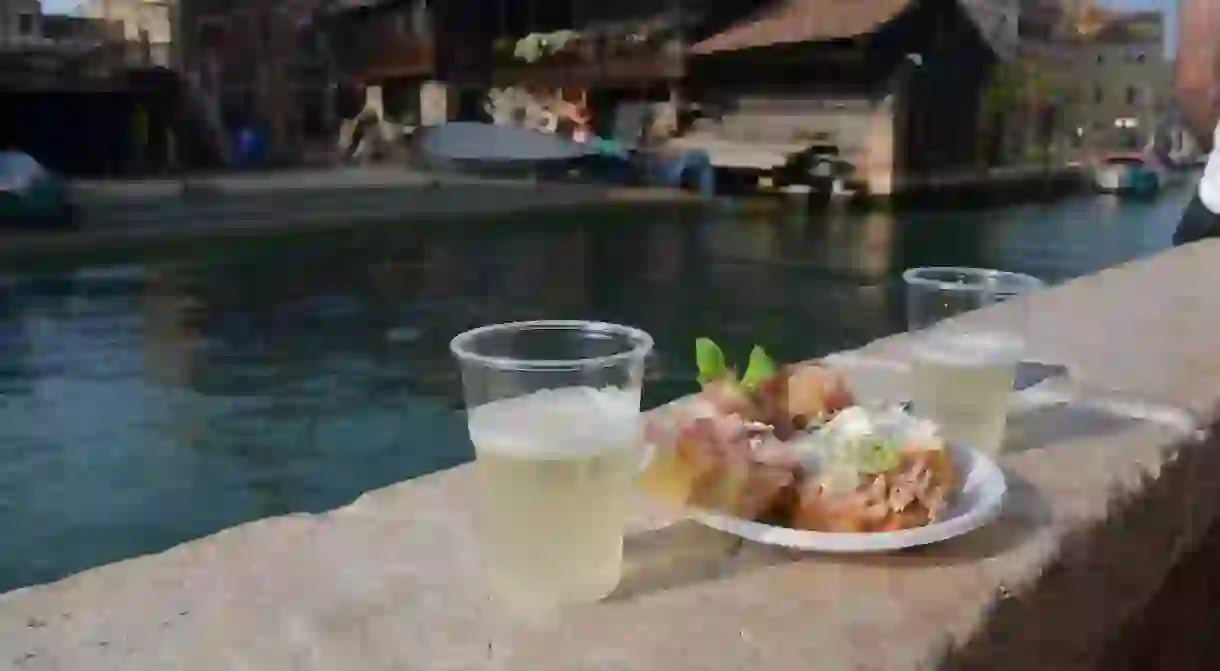Introducing Cicchetti, Venice's Answer to Tapas

Fried rings of squid, sarde in saor, wedges of cheese, and salame. Go into any good neighborhood bar in Venice and you’ll find a delectable spread laid out on the counter. In Venice, these snacks are called cicchetti. Similarly to Spanish tapas or Turkish meze, they’re little bites of savory food meant to go down with a glass of wine. Some places will offer fried things, others will spread fairy-sized pieces of bread with inventive toppings. You’ll find all kinds of seafood, meats and even little sandwiches made to order.
Food and drink in Italy are first and foremost, a social experience. That’s especially true in a city like Venice. For people who live here, the city can feel like a small town. The calle and campi are intimate and made for walking, which means stepping outside without running into friends and acquaintances is almost impossible. An important every day ritual is sharing a drink in the evening and eating a snack together.

It can be hard to eat out in Venice if you’re looking for authentic food on a light budget. Look no further than the little bacari tucked away all over Venice. Bacari are the local bars that can serve everything from your morning coffee to your evening grappa. Cicchetti normally cost between 1 and 3 euros each, so not only could you taste a few different things, you’ll also have no reason not to be adventurous. You can have some bites as an appetizer before dinner, or put together different plates to make a late lunch.
If you’re looking to experience a few different places, make sure to set out at least by late afternoon, as many can close around 7 or 8. All’Arco, one of the most beloved bacari very close to the Rialto market, closes around 5.

Bacari can become quite packed throughout the day, but the closeness of that space is also part of its charm. Step right up to the counter and confidently point at what you want. Be aware that if you want to sit down to take your food or drink, you’ll have to pay a higher price, since that counts as table service. Because of that, many Venetians will have their drink or snack standing at the bar. You can tuck in to your cicchetti wherever you find a bit of elbow room, or you can go out on the canal or street if the place allows it.

If you’re not sure if the bacaro you’re looking at is a good one, a clever gauge might actually be how crowded it is. The little bar called Alla Vedova is often packed in the evenings. That’s because you’ll find the most delicious meatballs in the city there, crunchy and perfect with a small glass of wine, or ombra. Another place that’s always full is Al Botteghon, where you’ll find all kinds of imaginative combinations served on little pieces of bread, from cheese with nettle pesto to garlicky baccala, the classic Venetian dish of creamed cod. Try the house specialty, tuna with mayonnaise and bitter cacao.

Some bacari have long and powerful histories. Al Botteghon, for example, has been run by three generations of the same family and you’ll still find the grandmother, Luisa, behind the counter. Ae Do Spade, in San Polo, dates back to sometime in the 15th century and Cantina Do Mori is probably the oldest, going back to 1462. Apparently Casanova often ate there and his autobiography recounts one Carnival in 1745 when he seduced a married noblewoman over dinner in that very same place. If you do go there, make sure not to miss the francobollo, a little sandwich with radicchio and gorgonzola. You’ll not only be tasting something delicious, you’ll also be supporting everything that makes this city unique and taking part in its history.













